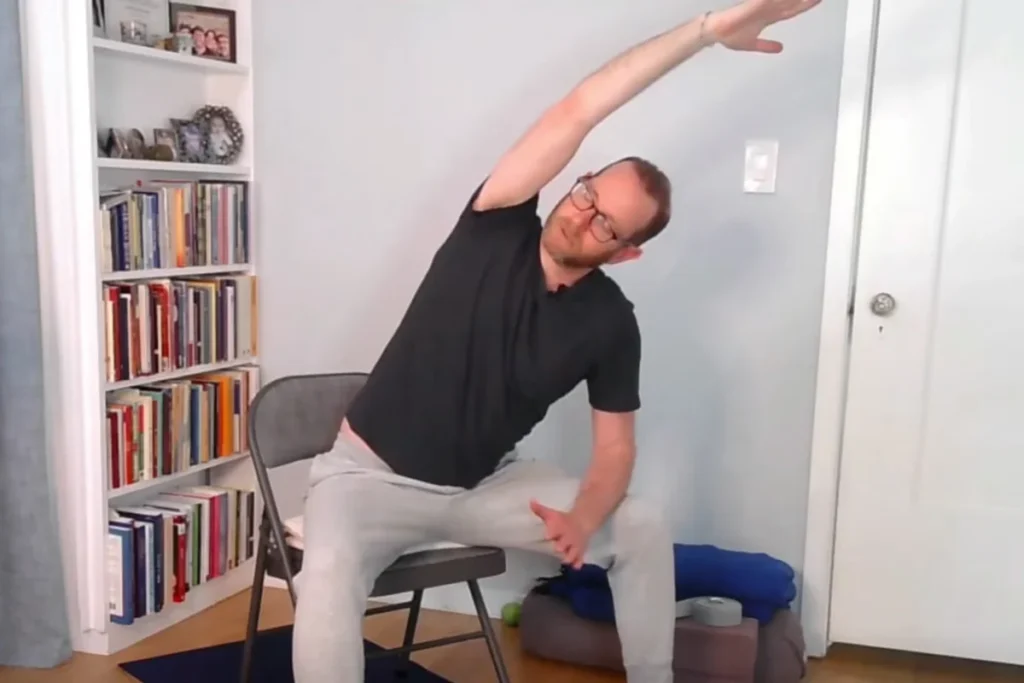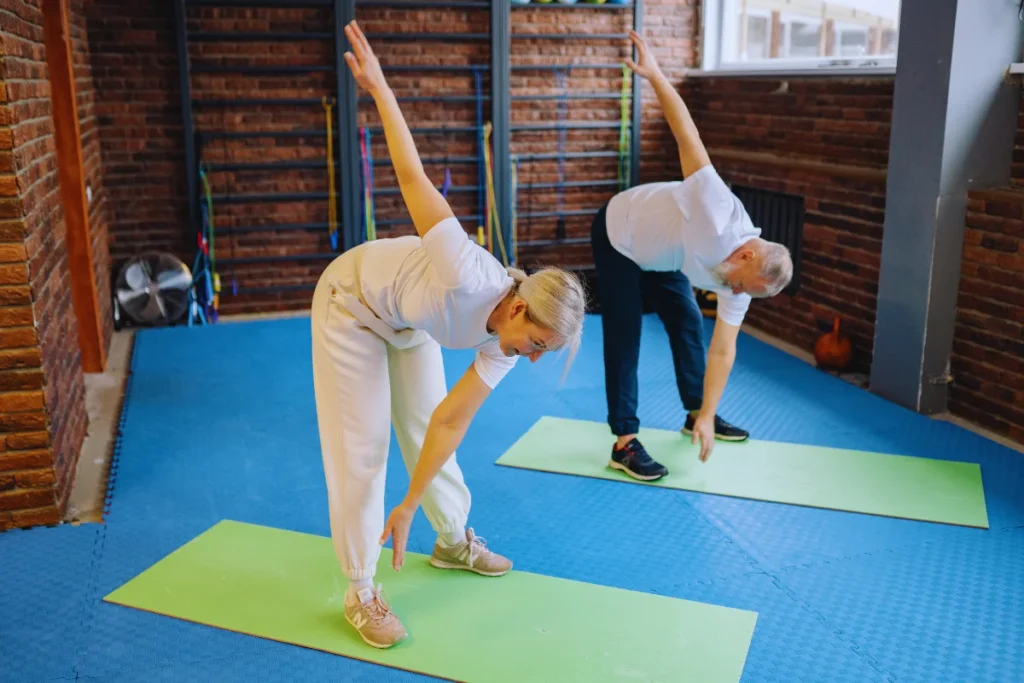Exercises for the elderly are gentle movements that help older adults stay steady, strong, and active. This blog includes 10 simple routines you can try at home, along with safety tips, easy ways to stay on track, and how Metro Care UK supports movement as part of daily care.
Table of Contents
Why Gentle Exercises For The Elderly Are Important
As we grow older, gentle movement becomes one of the easiest ways to stay healthy. It helps the body stay strong, steady, and active, without the need for anything intense or complicated.
Here’s how gentle exercises can make a real difference:
- Keeps you moving: Regular activity supports mobility, helping with walking, standing, and day-to-day movement.
- Builds strength and balance: Light movements improve stability and help prevent falls, especially important for those at home or in care.
- Supports independence: Staying active helps older adults manage personal tasks like dressing, preparing meals, or getting out of bed.
- Improves circulation: Gentle movement supports blood flow, easing stiffness and helping with cold hands and feet.
- Lifts your mood: Even short routines can reduce stress, improve sleep, and bring a sense of calm and purpose.
- Helps with joint pain: Safe exercises for older adults can reduce stiffness caused by arthritis or long periods of sitting.
- Easy to start: Seated or standing, these movements are simple and don’t need any special equipment.
A few gentle movements each day can help you feel steadier, confident, and in control.
Each person we support has a care plan in a care home that reflects their individual needs, including mobility and exercise.
Getting Started: Safety and Preparation
Before you begin any new exercise routine, it’s important to make sure you’re prepared. This helps reduce the chance of injury and makes your session more enjoyable.
Here’s a quick guide to help you prepare:
| Step | What to Do |
| Speak to your GP | Talk to your doctor if you have any medical conditions or concerns. |
| Prepare your space | Use a chair with arms, non-slip shoes, and have water nearby. |
| Go at your own pace | These gentle exercises should feel easy and manageable. |
| Listen to your body | If you feel dizzy or unwell, stop and rest. |
| What to avoid | Don’t rush, avoid slippery floors, and skip the session if you’re not feeling well. |
Taking a few minutes to prepare can make your routine safer and more effective, giving you the confidence to move with ease.
You can also read about the difference between learning difficulties and learning disabilities for a clearer understanding of support needs.
10 Gentle Exercises for the Elderly
Staying active is easier than you might think. These 10 gentle routines include chair exercises for the elderly and light standing movements to help with balance, strength, and mobility. They’re easy to do at home, with or without support. Take your time and rest whenever you need to.
Seated/Chair Exercises For Seniors
1. Seated Marching
Purpose: Keeps the legs strong and helps with blood flow.
How to do it:
- Sit upright in a sturdy chair, feet flat on the floor.
- Gently lift one knee as if you’re marching, then lower it.
- Repeat with the other leg.
- Keep going for 30 seconds, or as long as feels comfortable.
Safety Tip: Hold onto the chair arms if you feel unsteady.
2. Arm Circles (Seated)
Purpose: Keeps the shoulders moving and eases stiffness.
How to do it:
- Sit tall and stretch both arms out to the sides.
- Make small circles going forwards 10 times, then backwards 10 times.
Safety Tip: Keep movements slow and steady. If your shoulders feel sore, try smaller circles.
3. Seated Leg Extensions
Purpose: Strengthens the knees and thigh muscles.
How to do it:
- Sit up straight with your feet flat.
- Slowly straighten one leg out in front of you, then lower it.
- Switch legs and repeat.
- Do 10 on each side.
Safety Tip: Don’t force the leg fully straight if it feels uncomfortable.
4. Seated Side Bends

Purpose: Gently stretches the sides and helps with movement through the waist.
How to do it:
- Sit with feet flat and back upright.
- Lift one arm up and slowly lean to the opposite side.
- Come back to the middle and switch sides.
- Repeat 5 times each way.
Safety Tip: Keep movements soft, stop if you feel any strain.
5. Seated Shoulder Rolls
Purpose: Helps ease shoulder tension and improve posture.
How to do it:
- Sit comfortably with your arms resting by your sides.
- Slowly roll both shoulders forward in a circle 5 times, then backwards.
Safety Tip: Keep breathing steadily as you roll.
6. Seated Calf Raises
Purpose: Strengthens your lower legs and helps with walking.
How to do it:
- Sit with feet flat on the floor.
- Gently lift your heels off the ground while keeping your toes down.
- Lower your heels and repeat 10–15 times.
Safety Tip: Use the chair arms to steady yourself if needed.
Standing/Supportive Movements
7. Sit-to-Stand
Purpose: Builds leg strength and helps with everyday tasks like getting up from a chair.
How to do it:
- Sit near the edge of a chair, feet flat on the floor.
- Cross your arms or use them for support on your thighs.
- Slowly stand up, then gently sit down again.
- Repeat 5–10 times, resting if needed.
Safety Tip: Place the chair against a wall for extra stability.
8. Heel-to-Toe Walk (With Support)
Purpose: Helps improve balance and coordination.
How to do it:
- Stand behind a chair and hold the back.
- Step one foot directly in front of the other, with the heel touching the toe.
- Walk 10 steps in a straight line, then turn and return.
Safety Tip: Keep the chair nearby or ask someone to watch you during this exercise.
9. Ankle Rotations
Purpose: Keeps ankles loose and supports better walking.
How to do it:
- Sit or stand safely.
- Lift one foot slightly off the floor and slowly rotate your ankle in a circle.
- Do 10 times each direction, then switch feet.
Safety Tip: Go slowly, this is about movement, not speed.
10. Wall Push-Ups
Purpose: Strengthens arms and shoulders without needing equipment.
How to do it:
- Stand about arm’s length from a wall.
- Place your hands flat against the wall, shoulder-width apart.
- Bend your elbows slowly to bring your chest closer to the wall, then push back.
- Do 10–12 times.
Safety Tip: Keep your feet flat and your back straight. Stop if your arms feel strained.
These low-impact movements are simple, safe, and can be done seated or standing. Just a few each day can help improve strength, balance, and overall confidence.
We offer adult day care facilities that include gentle movement and daily routines for those needing support during the day.
Tips for Staying Consistent
Keeping up with daily movement is easier when it becomes part of your routine. Here are simple ways to stay on track:
| Tip | What to Do |
| Choose a regular time | Try after breakfast or before your afternoon tea. |
| Set reminders | Use a calendar, notebook, or TV show as a prompt. |
| Involve someone | Ask a friend, family member, or carer to join or encourage you. |
| Keep sessions short | 5 to 10 minutes a day is enough to feel the benefits. |
| Link to daily habits | Add exercises to something you already do, like watching TV. |
| Try seated routines | Many exercises can be done comfortably in a chair. |
| Start with easy moves | Focus on simple movements that feel comfortable and easy to begin with. |
Consistency is about small steps done often, not doing everything at once.
If you’re deciding between care options, it may help to understand the difference between a care home and a nursing home.
Conclusion
Gentle exercises for the elderly can help improve strength, balance, and confidence in daily life. Just a few minutes each day can support independence and make everyday tasks feel easier.
At Metro Care UK, movement is part of daily care. We guide residents through simple routines, often using chair-based exercises that are safe and easy to follow. For those with limited mobility, we offer quiet one-to-one support to help them move comfortably.
These small steps can make everyday tasks easier and help residents feel steadier and in control.
Want support for yourself or a loved one? Our team is here to help.
FAQs
What is the daily exercise for a 70-year-old?
For most 70-year-olds, daily exercise should include gentle movements that support mobility, balance, and strength. This can be a mix of light walking, chair exercises for seniors, stretching, or seated leg lifts. Even 10–15 minutes a day can help improve circulation and confidence in daily tasks.
What are the four main types of exercise that seniors need to stay healthy?
The four key types of exercise for seniors are:
1. Balance exercises: help reduce the risk of falls (e.g. heel-to-toe walks).
2. Strength exercises: maintain muscle and support joint health (e.g. sit-to-stand).
3. Flexibility exercises: improve range of motion and ease stiffness (e.g. shoulder rolls).
4. Aerobic activity: boosts heart and lung health (e.g. seated marching or light walking).
What is the number one exercise to increase balance in seniors?
One of the most effective balance exercises for older adults is the heel-to-toe walk. This simple movement strengthens the legs and helps train the body to stay steady. For those needing more support, it can be done while holding a chair or near a wall.
What are 4 ways exercise helps fight ageing?
Regular physical activity helps older adults age well in many ways. It can:
1. Keep muscles strong, making everyday tasks easier
2. Improve balance and coordination, reducing fall risk
3. Support heart and lung function, promoting better energy
4. Boost mood and mental clarity, reducing feelings of stress or forgetfulness

